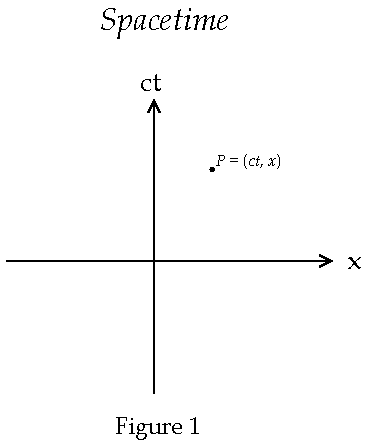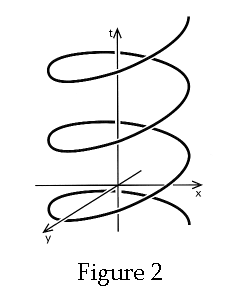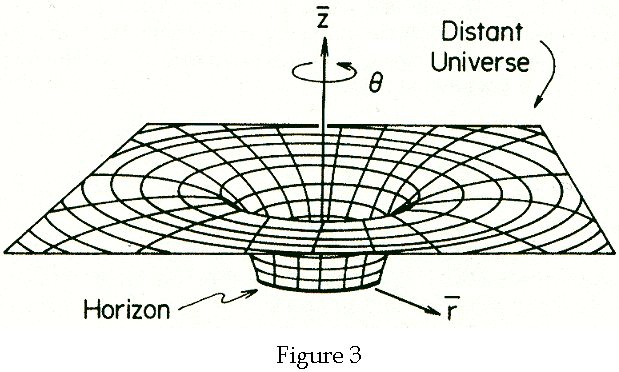
Gravitational Field vs
Spacetime Curvature
Back
to Physics World
Back to General Relativity
Spacetime
Curvature
The
concept of a gravitational field as manifested by spacetime curvature can be a
confusing concept. Spacetime is a collection of events where an event is
specified by a time, t, and place, (x, y, z), where an event is
sometimes labeled by X ļ
(ct, x, y, z). It one suppresses the y and z axes in a
spacetime diagram then it can be visualized as in Figure 1 below.

The
diagram is drawn with the idea that this spacetime manifold is a flat one. Such
a manifold can also be drawn with 3-dimensions. The spacetime diagram in Figure
2 below has the z-axis suppressed

The
curve shown in Figure 2 is called the worldline of a particle. In this
diagram the particle is moving in a circle, centered at the origin of
coordinates in the xy-plane. This space is also flat, however this fact
is not obvious in the spacetime diagram. If the coordinate lines were drawn then
it would look like the Cartesian space R3
when its coordinate lines are drawn. An
example of a non-flat space (not spacetime) is shown below for that of a black
hole

If
the diagram showed instead two coordinates, one for space and the other for
time, then this would look like a 2-d curved spacetime manifold.
Rely on your intuition for what the intrinsic curvature of a
manifold is. A cylinder does not have an intrinsic curvature. If you were to cut
the cylinder along its length then it would unfold into a flat rectangle.
However the surface of a two dimensional sphere, such as a basketball, has a
non-zero curvature. If you cut it and lay if on a flat surface then it would
retain its shape. This is the reason why itís so darn hard to wrap a
basketball!
Now imagine a
person walking on top of such a surface while all the while trying to in the
straightest possible line. Such a line is called a geodesic. On a flat
manifold if two geodesics, closely spaced, start off parallel geodesics then
they will remain parallel. However this is not true for a curved manifold.
Consider what this would be like in spacetime. Two closely spaced geodesics on a
curved manifold will, in general, deviate from each other. This phenomenon is
called geodesic deviation. These two people who are subject only to the
forces of gravity would not retain the same distance from each other. They would
get further apart or closer together (depending on their direction) as time
marched on. We know this phenomenon from Newtonian mechanics. Its called tidal
forces and is represented mathematically by the tidal
force tensor, which is a Cartesian tensor. As Kip Thorne states it spacetime
curvature and tidal gravity must be precisely the same thing, expressed in
different languages. [1]
Gravitational
Field
The
gravitational field is one of the most obvious of all physical phenomena that we
are exposed to. We are constantly subject to the Earthís gravitational field
all of our lives Ö unless youíre an astronaut that is. The gravitational
field manifests itself by holding an object at rest some distance above the
ground and then letting go. We all know what the result will be Ė the object
will fall. This is expressed easily by the simple equation
![]()
where g
= 9.8m/s2
. Eq. (1) simply means that the object will fall in the Ėz direction at
a rate of 9.8m/s2
regardless of the shape, mass or structure of the object. Eq. (1) is an
approximation of the gravitational field near the surface of Earth. At small
distances (~1 mile) the gravitational field will, for most practical purposes,
be uniform in this region. Gravitational tidal forces are far too small for
anyone to experience them acting on their body. Therefore for our entire lives
we will never directly feel gravitational tidal forces acting on our body. This
assumes, of course, that youíre not falling into a black hole where the tidal
forces will stretch and compress your body from different angles. In Newtonian
mechanics it is very clear what a gravitational field is. We place a test
particle at a point in space where only gravitational forces are acting on it.
If the test particle accelerates then there is a non-zero gravitational field at
that point. The fact that it merely accelerates does not give us enough
information to determine of there are tidal forces acting at the point. To make
that determination we would have to have either two test particles initially at
rest at the point with a small separation between the two and observe whether
they accelerate relative to each other or not. Or we could measure the
gravitational acceleration at various spatial positions around the point of
interest and then calculate the tidal forces acting there. If all the components
of the tidal force tensor vanish at the point then there is no tidal forces
acting at that point.
It is clear that there
is a large difference in the definition of tidal force and gravitational
force. So when you hear that gravity is a curvature in spacetime you must
understand that the person who makes such a statement is saying that tidal
forces and gravity are the same thing. This, of course, goes contrary to our
intuition. This was not the way Einstein defined the gravitational field. He
defined it such that it is consistent with Newton. Others realized that
Einsteinís definition meant that the existence of a gravitational field would
depend on the frame of reference of the observer. Since Einsteinís day,
physicists did not like the relative existence of a gravitational field. Since
tidal forces canít be transformed away most relativists chose to identify
gravity with tidal forces. It is this reason that people say that gravity is
a curvature in spacetime.
References:
[1] Black
Holes & Time Warps: Einsteinís Outrageous Legacy, by Kip S. Thorne, W.W.
Norton & Co., (1994).
Back
to General Relativity
Back to Physics World